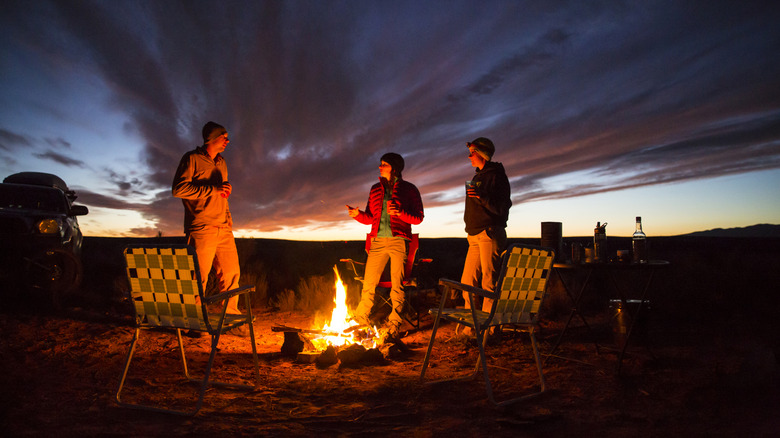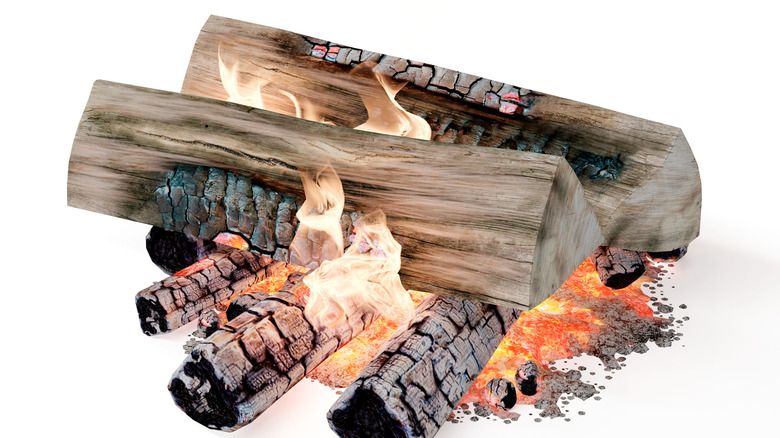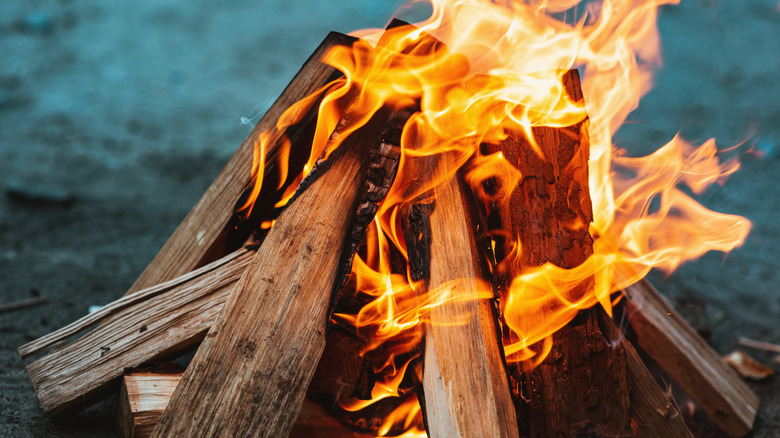This Foolproof Campfire Starting Method Is A Timeless Classic Every Camper Should Master
Starting a campfire is easy. If you have dry fuel and a match, the flames should shoot up in seconds. One lighter will turn a bundle of paper into a small fireball. Add some sticks and the fire will burn a bit longer, eating away at the narrow shafts of bark and wood. Smoke will puff from the conflagration, and you'll feel a sudden burst of heat.
But building a good fire is something else entirely. Rookie outdoorspeople often struggle with campfires, incinerating piles of newspaper and kindling before the whole thing stalls out. They may even know the rule about the "pyramid," a bundle of sticks that lean against each other in a kind of cone. The fire starts, shimmying up the sticks and puffing smoke out of the top, but the moment you add bigger logs, the fire fails. Maybe the flame gets smothered. Maybe the split edge doesn't catch. One way or another, the fire runs its course, and all you're left with are some black embers and uncooked s'mores. The amateur camper wonders: How to get this campfire roaring?
If this is you, don't worry. Campfires are an art, and they require practice. Like tent camping, fires don't have to be intimidating. If you can heat up some kindling, that's a great start. The next step is to build a "log cabin," a structure that will encourage the blaze to spread to ever-larger chunks of wood and gradually become bigger and hotter. Assuming you can find dry wood to burn, this simple technique should ignite — and maintain — a comforting fire.
How to build a log cabin campfire
Building a "log cabin" fire is exactly as it sounds: You set two or more pieces of wood next to each other on the ground, then add two or more additional pieces on top of those, but perpendicular to the first. You could keep stacking like this, assembling a tower of wood, but two to three layers are probably enough to get you started. The fire starts in the middle, then burns upward and outward, gradually devouring the wood as it hungers for more fuel.
Why does the log cabin work? The most important ingredient for any campfire, aside from something combustible, is air flow. Fires require oxygen to keep burning, and the openings in the log cabin help ease air between the hunks of wood. The arrangement is also vertical, because flames flicker upward; the more guidance they have, the more easily the fire will burn. If you can imagine the opposite situation — logs lying next to each other, flush and flat — any fire would end up dying out.
The log cabin may also prevent a young fire from blowing out, as can sometimes happen on windy days; the split logs form a protective wall around the flame, reducing the breeze. If your logs are moist, the log cabin keeps heat contained as you add more dry kindling; this is a common tip for starting a campfire with wet wood, and the structure should eventually dry out as the flames continue to crackle inside.
Log cabin fires vs. pyramid fires
Building that "pyramid" out of kindling is always a good idea, and it's something you can place inside your log cabin. Once the larger pieces of wood are ablaze, you can maintain that square structure, adding logs as the others break down into glowing coals. The log cabin is ideal for general size and warmth since the heat emanates in all directions (give or take the push of the breeze).
Alternatively, you can arrange the larger chunks of wood as a pyramid as well. This kind of structure sends flames directly upward, concentrating heat in the middle, which is better for cooking. In established campsites, you usually have a metal ring or brick enclosure with a grill, and adding a pyramid fire will aim heat at the meat and veggies directly above. The same goes for skewers for hot dogs and marshmallows, or grills and pots hanging from tripods.
In theory, there are several other layouts as well, and survivalists and Boy Scout troops will no doubt study each one. For most campers, log cabins should do the trick, especially for couples and groups who just need a source of warmth and light. If you anticipate difficult conditions, such as rain, high winds, or limited fuel, this genius backpacking hack will make starting a campfire a breeze.


